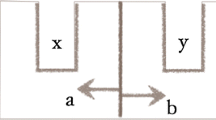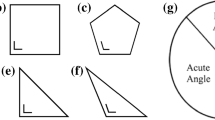Abstract
In this paper I argue that holes are not objects, but should instead be construed as properties or relations. The argument proceeds by first establishing a claim about angles: that angles are not objects, but properties or relations. It is then argued that holes and angles belong to the same category, on the grounds that they share distinctive existence and identity conditions. This provides an argument in favour of categorizing holes as one categorizes angles. I then argue that a commitment to the existence of properties to be identified with holes provides sufficient resources to account for true claims about holes.
Similar content being viewed by others
Notes
More will be said on this view later. See Sect. 4.
See Levinson (1978)
See Lowe (2006, p. 72).
The examples I concentrate on in this section are two dimensional angles, but I discuss three dimensional angles in Sect. 4.
Even in the more inflated ontology which acknowledges also the property that is the angle and the measure of it, there is no object in addition to the figure.
See, for example, Wake et al. (2007).
See Sorensen (2008)
References
Armstrong, D. M. (1974). Infinite regress arguments and the problem of universals. Australasian Journal of Philosophy, 52(3), 191–201.
Armstrong, D. M. (1997). A world of states of affairs. Cambridge: Cambridge University Press.
Casati, R., & Varzi, A. (1995). Holes and other superficialities. Cambridge: MIT Press.
Casati, R., & Varzi, A. (2004). Counting the holes. Australasian Journal of Philosophy, 82, 23–27.
Levinson, J. (1978). Properties and related entities. Philosophy and Phenomenological Research, 39(1), 1–22.
Lewis, D., & Lewis, S. (1983). Holes. In D. Lewis (Ed.), Philosophical papers (Vol. I, pp. 3–9). Oxford: Oxford University Press.
Lowe, E. J. (2006). The four-category ontology: A metaphysical foundation for natural science. Oxford: Oxford University Press.
Sorensen, R. (2008). Seeing dark things: The philosophy of shadows. Oxford: Oxford University Press.
Wake, A., Spencer, J., & Fowler, G. (2007). Holes as regions of spacetime. The Monist, 90(3), 372–378.
Author information
Authors and Affiliations
Corresponding author
Rights and permissions
About this article
Cite this article
Meadows, P.J. What Angles Can Tell Us About What Holes Are Not. Erkenn 78, 319–331 (2013). https://doi.org/10.1007/s10670-011-9318-7
Received:
Accepted:
Published:
Issue Date:
DOI: https://doi.org/10.1007/s10670-011-9318-7




